
... einige meiner bevorzugten Gottheiten:

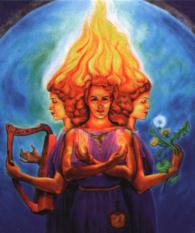 |
Brigid:
Der Name bedeutet im Englischen "bright", also hell und strahlend. Andere Auslegungen übersetzen den Namen als "Feuriger Pfeil" oder "Macht". Sie ist eine "threefold", also eine dreigestaltige Gottheit, und ihre Gestalten sind Feuer (Inspiration und Schmiede), Poesie und Heilung. Ihre Heilkräfte waren so stark, daß ihr Atem den Toten neues Leben einhauchen konnte. Die Legende über die heidnische Brigid erzählt, bei ihrer Geburt sei eine Flamme aus ihrem Kopf hervorgeschossen, die sie mit dem Universum verband. Ihr heiliges Feuer in Kildare brannte ununterbrochen und wurde von 19 Priesterinnen gehütet (in einigen Überlieferungen sind sie rituelle Prostituierte). |
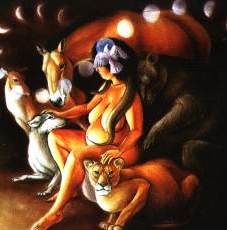 |
Astarte
Astarte Die Herrin der wilden Tiere. Zusammen mit Lilith ist sie eine der hohen Elohim (dieses hebräische Plurale tantum bedeutet "Göttinnen und Götter", obwohl es seit 2.000 Jahren von Bibelübersetzern als "Gott" interpretiert wird) der Semiten Phöniziens. Die Gefährtin Balls wird oft mit Tieren in ekstatischem Tanz dargestellt. Sie war die Große Göttin, allmächtig, erschaffend, erhaltend und zerstörend, die Verkörperung von Mutter Natur. |
| Baba Yaga:
Sie ist die Wächterin der Wasser des Lebens. In der mündlichen Überlieferung der slawischen Völker ist sie die Weise Alte des Herbstes, die in der letzten Korngarbe der abgeernteten Feldern haust. Passenderweise hieß es, daß die Frau, die eben diese Garbe gebunden hatte, im nächsten Frühjahr entbinden würde. Sie reitet in einem Mörser durch die Lüfte, den sie mit ihrem Besen rudert und mit dem Stößel lenkt. Daraus kann man ableiten, daß sie mit Kräuterwissen und medizinischen Kenntnissen in Verbindung gebracht wurde. Erst im Mittelalter verwandelten die Legenden sie in die böse kinderfressende Hexe. Ihre wahre Natur als kluge, heilkräftige und daher machtvolle Alte sollte nicht in Vergessenheit geraten! |
|
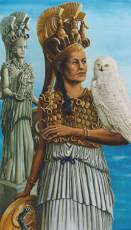 |
Athene
Greek Goddess of culture, wisdom, laws, crafts, and political and military strategy. Her symbols included the owl (wisdom) and the snake (ancient symbol of female power). Patriarchal Greek mythology tells of Athena being born from Zeus's head after he swallowed her mother, Metis. However, Metis can be traced back to North Africa as Medusa whose snake hair symbolized female wisdom. Athena was the virgin form of the triple Gorgon Mother of Fate: Neith; Metis or Medusa; Anath or Ath-enna. Originally, it was said that she was born in Libya from the uterus of Lake Tritonis (3 Queens). Athena is wearing a helmet with two horses, symbolizing the belief that it was she who first tamed the horse and invented the bridle and chariot. |
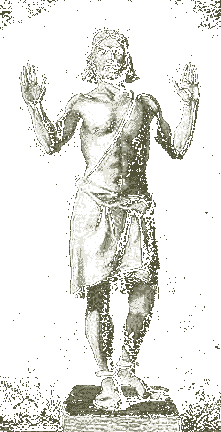 |
Baldur
May the Force of the Good God Be With You. Golden-haired Baldur, most merciful and sweet-tempered god of the Norwegian pantheon, is yet another name for the sacrificial deity Baal. Even the stones wept when trickster Loki caused his death. For the Scots and Irish,during the era of Viking conquest there, his effigy burned in the Beltain (Mayday) bonfire emblemized Baldur's promised Second Coming after the death of the old order of gods. His symbolic body, eaten in the Beltain cake, may have given rise to the "gingerbread man" of fairy tales. We have adapted this Baldur image from the 8th century CE Oseberg Bucket (Olkasamling University Museum, Oslo). Notice the order and balance of the pattern on his chest, probably a form of the ancient svastika, or "Thor's hammer," guaranteeing well-being and good fortune. |
| Bast
Her holy city Bubastis possessed Egypt's greatest temple. She is depicted enthroned as the cat-headed incarnation of Isis. Related to Neith, the Night Goddess, Bast symbolized the moon in its function of making a woman fruitful, with swelling womb. She was also the Egyptian goddess of pleasure, music, dancing and joy. Here's an image of the Cat. |
|
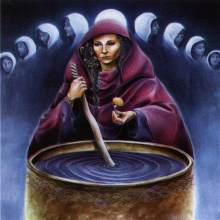 |
Cerridwen
The Welsh Triple Goddess. Her cauldron was the Celtic symbol for prosperity and rebirth, and she herself is the Mother Goddess, famous for nurturing her children. Her totem animal, the corpse-connected white sow, represents the moon as well as Kerridwin's crone/transformatrix aspect. The great bard Taliesin (often thought to be Merlin), born of the goddess according to a favorite Celtic regeneration myth, attributed his magic talents to her. She can be equated with Greek Demeter, Anatolian Diana of Ephesus, and Kali, all goddesses who both give and take away. |
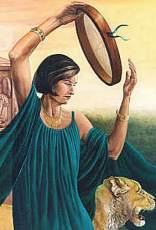 |
Cybele/Rhea
Mother Earth. From Pre-classic Greece to early Christian times she represented Gaia, the deified earth, and inherited many attributes of the ancient Sumerian goddess Inanna . In this depiction Cybele's queenship as Magna Mater of Rome is symbolized by her throne and lions. She holds the frame drum; her bowl of prophecy and staring gaze proclaim her power. The blazing torch symbolizes her bull-consort Attis in resurrection. Saint Peter's Cathedral stands upon the site of Cybele's temple in Rome. The Sybils at Cumae were her priestess-oracles. |
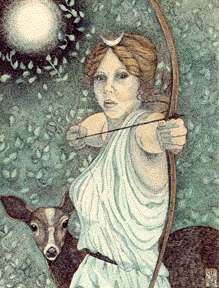 |
Diana/Artemis |
 |
Durga
Symbol of Cosmic Harmony. The warrior goddess, riding upon a lion and wielding a weapon in each of her 10 arms, corresponds with Inanna . She is depicted calm-faced and smiling as she defeats the buffalo demon. The latter symbolizes that egoistic force of maya (the everyday world) which deludes individuals and keeps them from knowing their innate nature as god. Durga, the fierce and creative shakti aspect of Godhead, emanates from the mother Parvati to restore order in the world and peace in the heart of suffering devotees in any time of crisis. |
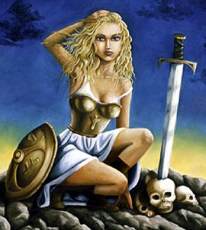 |
Freya
Goddess of Love and Fertility. She ruled Odin's Valkyries and is reputed to have taught him women's mysteries. Together with her consort-brother Frey she was ruler of the Vanir, ancient matrifocal nature deities who pre-existed Norse patriarchy. great necklace Brisingamen. Goddess of the moon, of love, and of childbirth, she gave her name to Friday. |
| Ganesh
An archetype of All-Wisdom and Beneficence. The deity of good fortune, new ventures, wisdom and removal of obstacles, his attributes are shell, discus, club and water lily, held in each of his four hands, and his vehicle is a rat. Huge yet gentle, humble enough to ride upon the insignificant rat, his figure in its totality represents the indivisible universe. In his dancing form, serpent-belted, Ganesh evokes the tremendous creative power of his father Shiva. Lotuses at his feet magnify Ganesh's fertility. |
|
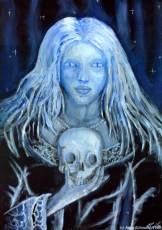 |
Hecate
Auch sie eine dreigestaltige bzw. dreiköpfige Göttin. Die Tochter des Titanen Perses und der Titanin Asteria kam aus Kleinasien nach Griechenland und wird oft mit Selene, Artemis und Persephone gleichgesetzt. Sie herrschte unter anderem über die Nacht, die Toten und die Unterwelt, weswegen man sie oft nachts an Gräbern oder Kreuzwegen anrief.. Ihr zugeschrieben werden eine Fackel aus Mondlicht, die Schlange der Unsterblichkeit und ein Hebammenmesser. Andere Darstellungen zeigen sie zusätzlich mit Stricken und Schlüsseln und in der Begleitung heulender Hunde. Die Verrufenheit als Königin schwarzmagischer Hexen ist wohl eher eine christliche Verleumdung; esheißt, daß sie in mittelalterlichen Ackerbaukulturen hauptsächlich für ihre Heilkräfte verehrt wurde. |
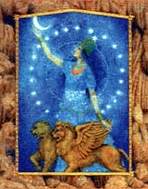 |
Inanna
The Queen of Heaven and Earth. The flowering of Sumeria, its temples, ordered cities, irrigated fields, birthplace of cuneiform writing and codes of law, and mastery of terra-cotta arts, all offer tribute to this earliest named Great Goddess. Worshiped as early as 7000 BCE, Inanna was still widely revered after patriarchal incursions into the Euphrates plain. She descended from heaven to bring prosperity to Her people, then descended into the Realm of Death in a quest for wisdom. Returning, she condemned her lover and son Dumuzi to replace her there in punishment for his arrogance; their annual sexual union was viewed as the source of fecundity and plenty. |
 |
Isis
At the apex of her influence, this Goddess of Rebirth was worshiped throughout the Greco-Roman world. Her temples were finally closed in the 4th century AD, but her role as Mother of God, as well as many other Christian borrowings from her mythos, were assumed by the Virgin Mary. Originally Isis was known as Au Set, a predynastic Egyptian Goddess dating from 3000 BCE. She laid upon the dead body of her husband-brother,Osiris (whose annual death symbolized the fertilizing of fields by Nile floodwaters), and conceived Horus, the falcon-headed deity who is the original "son of God(ess)." The name Isis means "throne woman," and she was venerated as the inventor of agriculture, law and medicine, and as the Mother who placed the sun god Ra in the sky. According to Egyptian scriptures, "in the beginning there was Isis, Oldest of the Old, the Goddess from whom all becoming arose. |
 |
Kali
Goddess in the aspect of Liberator. Unlike much Western mythology, Hinduism at all times has recognized the feminine principle, most prominently in the form of consort to Shiva or Shiva-Shakti. The male power, inert, is useless without this energizing female power, conceived of in its benign form as Parvati, and in its fierce or destructive form as Kali. In this terrifying aspect, the goddess drips blood from her devouring mouth, and her huge sword has beheaded the demon Ignorance, while her other two hands signify the blessing implied by this penultimate spiritual deed. The Ancient Goddess, in her warrior aspect of Inanna, Medusa, Athena or served a similar psycho-spiritual function in western cultures. |
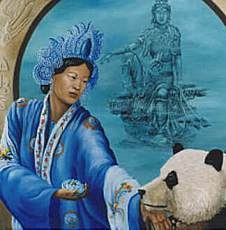 |
Kuan-Yin
Goddess of Mercy. Seated upon a weathered stonefrom which healing waters pour, this reproduction of a Chinese sculpture(10th-11th century) depicts the goddess in royal ease posture, ready to riseand help those in need. Here, Kuan-Yin images the equipoise we aspire to whileimmersed in our daily round. Her distinctly androgynous features emphasize thetao of yin and yang, the dance of opposites in balance, which creates innerpeace. Kuan-Yin corresponds with Artemis, Greek goddess of field and forest andto the healing Celtic water-goddess Sequana. |
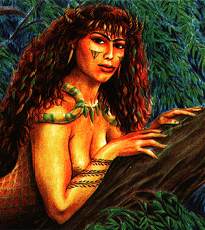 |
Lilith
Dating to 2300 BCE or earlier, Lilith is the first feminist. While she is referred to as a demon by Levite priests, this is likely due to her assertive behavior at a time when patriarchy was new. A Sumerian, Hebrew and Muslim Goddess, she is referred to anciently as the hand of Inanna who gathered males into the temple for sacred sexual rites. In our tradition she was the original wife of Adam, with whom she claimed equality because they were created together in the image of Elohim (a word for God which had feminine as well as masculine linguistic roots). A Goddess of childbirth, she holds the rod and ring of Sumerian royal authority, wears a stepped crown, perhaps symbolic of lunar cycles, and is guarded by the bird of wisdom and the king of beasts. |
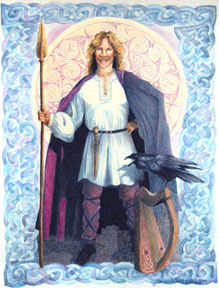 |
Lugh
Celtic Lord of Every Skill. He was patron of Lugodunum (Lyons) in Gaul. He and his nature goddess consort (named variously as Tailltu, Machta or Gaulish Rosmerta) were worshiped during the 30-day Lugnasad midsummer feast in Ireland as well. Sexual magic during this festival ensured ripening of the crops and good harvest. Called Lamfhada (or of the long arm) in Gaelic because of his great spear and sling, his animal totems were the raven and the lynx. Lugh mirrors Hindu Kartikeya , the spiritual warrior, and Roman Mercury, the swift messenger, and his exploits are recounted in the Celtic epic Tuatha De Danann. |
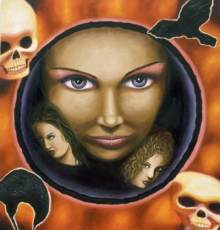 3 3 |
Macha & Morrigán
Macha was an Irish war goddess, often seen (like her sisters Morrigan and Badbh) as one entity with three aspects: prophet, warrior and matriarch/queen. But Macha probably predated the Celtic Gaels as a prehistoric Asian moon goddess. She was associated with the crow, as well as with the ability to outrun the king's horses, and she cast a famous curse on the hero Cu Chulainn. Celtic Goddess of Destruction/Creation. Elaborated from an Epona plaque, this image depicts the Irish triple goddess: Ana, the fertility maiden; Badb, the boiling mother cauldron, producer of life; and Macha, the death-crone symbolized by the carrion-devouring raven. Oral tradition says the Celtic dying god Cu Chulainn was met by the beautiful chariot-mounted goddess with red eyes and cloak. She cursed him to death that his blood might fertilize the earth, then transformed herself into Badb Catha, the Raven of Battle who induces panic in warriors. The Morrigan evolved into Morgana Le Fay, sorceress of Arthurian legend. |
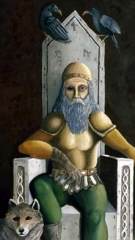 |
Odin
Lord of Wisdom, Death and Magic. This king of the gods sacrificed an eye to obtain wisdom and hanged himself (he is the Hanged Man of tarot) for nine days from the world ash Yggdrasil to learn the magical use of runes. Like his son Balder, Odin offered sacrificial blood and suffered death in the Hel underworld; each served the year-king function in Norse culture. Odin inspired warriors to ecstatic wildness. |
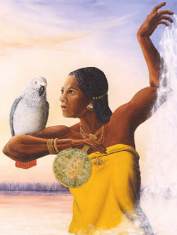 |
Oshun |
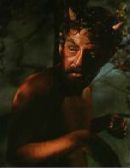 |
Pan
Ancient God of Sacrificial Fertility. He was the goat-hooved and lusty king of the Arcadian forest, the original Horned One. His Neolithic cult was later subsumed in the ecstatic wine-rituals of Dionysian Greece. This seated representation shows the god in his prankster or "puckish" mode, horned, ithyphallic and seated upon a hummock. The first tragedy (in greek-tragoidos-meaning "goat song") told the sacred story of his death and ressurection. Pan is the quintessential woodland god, demonized by the Church to diminish his powerful influence upon rural folk across Europe. |
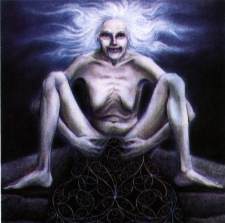 |
Sheela Na-Gig
The Goddess Displaying Her Parts. This Celtic archetype of the Great Mother appeared in folk and church art by at least 1080 AD, but undoubtedly is of much earlier origin. She may be identical with the war goddess Morrigan , consort to the Dagda . One of her images is found near the ancient goddess shrine of Avebury, where she symbolized fertility; displaying her sexual parts was believed to ward off evil. Carvings of Sheela-na-Gigs may have accompanied the seasonal harvest custom of weaving corn dollies which dates from North European antiquity. |
 |
Sri Lakshmi
The Goddess of Abundance and Prosperity. Depicted seated upon or holding the lotus, symbol of spiritual purity, fertility and vegetative growth, the goddess Sri (Laxmi) is venerated, like Ganesh , for her auspicious nature. She carries a coffer and gold coins shower from her hand, and she represents the supreme divine principle which pervades all creation with vitality and consciousness. Actively venerated by nearly 1 billion Hindus, Laxmi is the modern face of the ancient Great Mother Goddess; stalks of grain surrounding her head connote a rich harvest. |
| Quellen:
D.J. Conway: Celtic Magic A.S. Marashinsky: The Goddess Oracle Marian Green: A Witch alone Gerhard Fink: Who is who in der antiken Mythologie Kris Waldherr: The Goddess Myths |
|
|
|
|
|
|
|
|
|
|
|
|
|
|
|
|
|
|
|
|
|